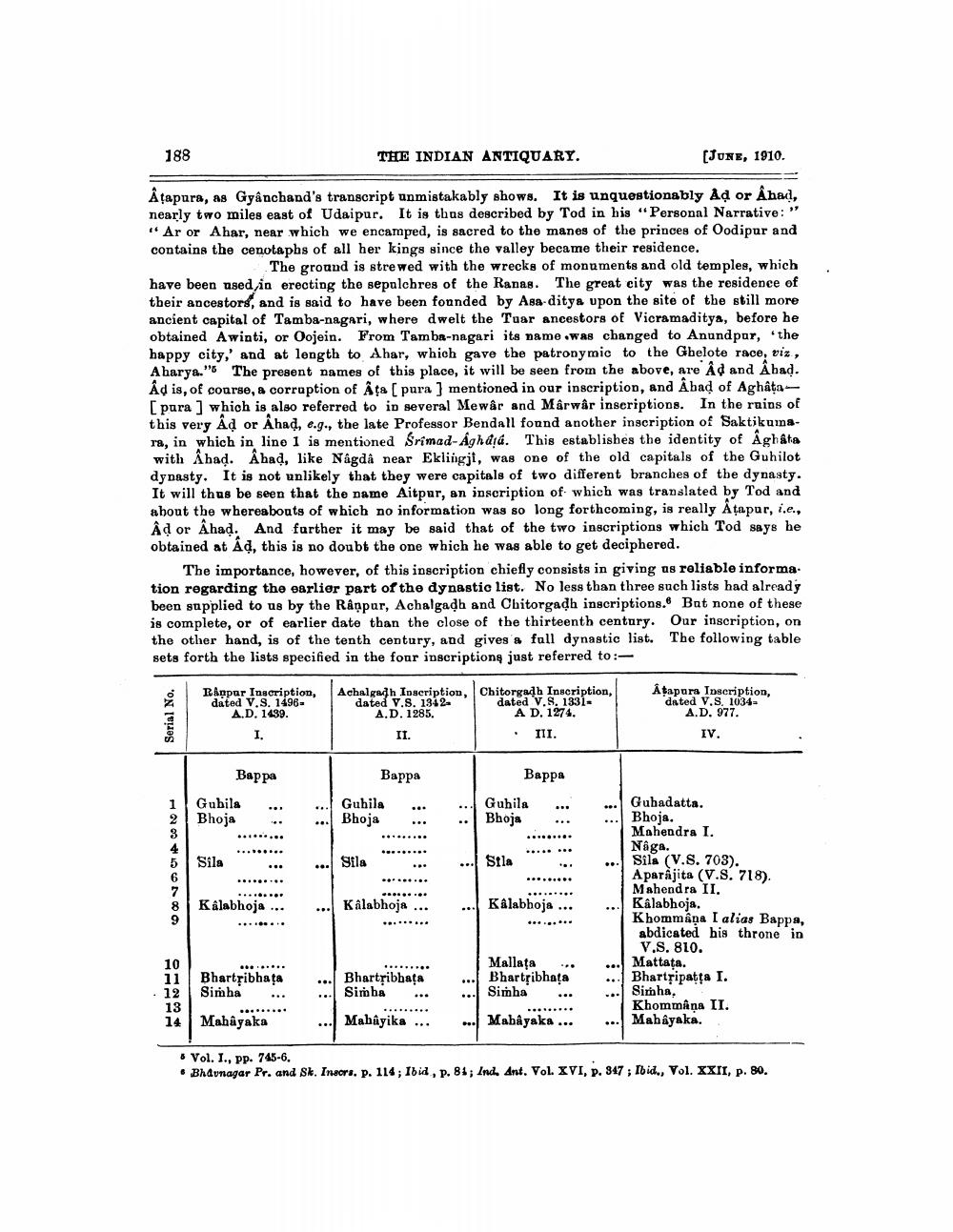________________
188
THE INDIAN ANTIQUARY.
(JUNE, 1910.
Atapura, as Gyânchand's transcript unmistakably shows. It is unquestionably Ad or Åha, nearly two miles east of Udaipur. It is thus described by Tod in his "Personal Narrative: " "Ar or Ahar, near which we encamped, is sacred to the manes of the princes of Oodipur and contains the cenotaphs of all her kings since the valley became their residence.
The ground is strewed with the wrecks of monuments and old temples, which have been used in erecting the sepulchres of the Ranas. The great city was the residence of their ancestors, and is said to have been founded by Asa-ditys upon the site of the still more ancient capital of Tamba-nagari, where dwelt the Tuar ancestors of Vicramaditya, before he obtained Awinti, or Oojein. From Tamba-nagari its name.was changed to Anundpur, the happy city,' and at length to Ahar, which gave the patronymic to the Gbelote race, viz, Aharya." The present names of this place, it will be seen from the above, are Âd and Âbad. Ad is, of course, a corruption of Ata [pura ) mentioned in our inscription, and Abad of Aghâta[ pura ] which is also referred to in several Mewâr and Marwâr inscriptions. In the ruins of this very Âd or Ahad, e.g., the late Professor Bendall found another inscription of Saktikumsra, in which in lino 1 is mentioned Srimad- Aghatá. This establishes the identity of Aghata with Åhad. Å had, like Nägdå near Eklingji, was one of the old capitals of the Guhilot dynasty. It is not unlikely that they were capitals of two different branches of the dynasty. It will thus be seen that the name Aitpur, an inscription of which was translated by Tod and about the whereabouts of which no information was so long forthcoming, is really Atapur, i.e., Âd or Ahad. And further it may be said that of the two inscriptions which Tod says he obtained at Ad, this is no doubt the one which he was able to get deciphered.
The importance, however, of this inscription chiefly consists in giving us reliable informa. tion regarding the earlier part of the dynastic list. No less than three such lists had already been supplied to us by the Raņpar, Achalgadh and Chitorgadh inscriptions. But none of these is complete, or of earlier date than the close of the thirteenth century. Our inscription, on the other hand, is of the tenth century, and gives & full dynastic list. The following table sets forth the lists specified in the four inscriptione just referred to:
Rappar Inscription, dated V.S. 1496
A.D. 1499.
Achalgadh Inscription, Chitorgadh Inscription, dated V.S. 1342 d ated V.S. 1331A.D. 1285.
A D. 1274, II.
• III.
Atapura Inscription, dated V.S. 1034
A.D. 977.
IV.
Seria
Bappa
Bappa
Bappa
... Guhila
1 2
Gubila Bhoja
..
Gubila ... Bhoja
...
Guhila Bhoja
...
Sila
Sils
...
... Sila
..
| Kalabhoja ...
Kalabhoja ...
Kalabhoja ...
Gubadatta. Bhoja. Mahendra I. Nâga. Sils (V.S. 703). Aparàjita (V.S. 718) Mahendra II. Kalabhoja. Khommâna I alias Bappa, abdicated his throne in
V.S. 810. Mattaţa. Bhartripatta I. Simha, Khommâņa II. Mahîyaka.
11
Bhartsibhata Simha
Bhartsibbata Simba ..
Mallata Bhartribhaga Simha
.
Mahayaka
Mabûyika ...
... Mahayaka ...
• Vol. I., PP. 745-6. • Bhavnagar Pr. and Sk. Incore. P. 114; Ibid, p. 81; Ind. Ant. Vol. XVI, p. 347; Ibid., Vol. XXII, p. 80.




